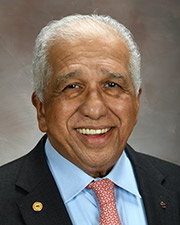The Promise of Plerixafor in Glioblastoma Treatment
 A Q&A with Adan Rios, MD; Professor in the Division of Oncology-Department of Internal Medicine of The University of Texas McGovern Medical School at Houston, Texas Medical Center; adan.rios@uth.tmc.edu
A Q&A with Adan Rios, MD; Professor in the Division of Oncology-Department of Internal Medicine of The University of Texas McGovern Medical School at Houston, Texas Medical Center; adan.rios@uth.tmc.eduQ: Glioblastoma multiforme (GBM) remains a scourge with a typically rapid fatal course resistant to most therapy. All solid tumors must receive sufficient blood supply to grow. Plerixafor is an FDA-approved drug that may inhibit tumor angiogenesis. How might plerixafor be sensibly used off-label as an adjunctive therapy for GBM?
A: Glioblastoma multiforme (GBM) is a CNS (central nervous system) tumor with post-therapy median time to progression of 7 months and median overall survival of 15 months. I decided to use plerixafor for the prevention of recurrence of GBM in one patient treated with standard chemo-radiotherapy five years ago and since then have studied this patient and this subject in depth.
The decision to recommend plerixafor to this patient was borne out from the availability of a human xenograft mice model of GBM developed at Stanford University and in which a variety of experimental conditions clearly demonstrated clinical impact on survival by using plerixafor as an adjuvant to treatment of the experimental GBM with radiotherapy and temodar. An interesting aspect of this model was that plerixafor, on its own, did not have direct anti-tumor effect. This lack of plerixafor anti-tumor effect in the absence of effective established therapy may explain the failure of clinical Phase I-II trials of plerixafor alone in patients with relapsed GBM. In these trials plerixafor was administered intravenously in escalating doses and for periods of up to one month, undoubtedly reaching levels that would have demonstrated direct anti-tumor activity against GBM, should plerixafor have such activity.
It must also be pointed out that the mechanism invoked for the activity against GBM in the Stanford experimental model has less to do with the anti-angiogenic characteristics of plerixafor and expression of CXCR4 receptors by the tumor and endothelial cells and more to do with the active blocking of bone marrow-derived myeloid precursors (BMDCs, MMP-9 expressing CD11b+ myelomonocytes). In the presence of active chemo-radiotherapy against GBM, this active blocking rescues the tumor from the effects of treatment by a process known as vasculogenesis, in opposition to primary angiogenesis. Chemo-radiotherapy eliminates the endothelial cells of the tumor (responsible for primary angiogenesis) resulting in an increased production of hypoxia-dependent HIF-1 and an increased secretion of SDF-1 (CXCL12), the cognate ligand of the CXCR4 receptor, by the tumor and stromal tumor-bed cells. This causes a specific increase mobilization and retention in the tumor bed of BMDCs initiating the tumor recurrence through vasculogenesis. This SDF-1 effect (hypoxia-dependent) can be blocked by plerixafor, an inhibitor of SDF-1-CXCR4 interactions.
The first patient I treated with plerixafor had a relapse of GBM after being free of disease for five years and one month. The small area of relapse was treated with gamma knife and initiation of avastin combined with plerixafor, with no change in his performance status or quality of life. Three other patients of mine are on adjuvant plerixafor off label. One had an early relapse resected and is now back on temodar, an “electric cap,” and continuation of plerixafor. The other two are about to complete one year on adjuvant plerixafor, and while is too early to comment further, they have experienced no unexpected events.
Stanford University’s clinical trials with plerixafor as an adjuvant to chemo-radiotherapy have had ambiguous results that were not as dramatic as expected from the experimental model. I have attributed this to the plerixafor schedule used at Stanford; they administered plerixafor in high doses, but only for the duration of the initial chemo-radiotherapy, and then stopped it. In contrast, the approach I have used is to administer plerixafor on weekly doses until the patient overcomes two critical thresholds: the 7 months of median for progression and the 15 months of overall survival. Plerixafor is long-acting and thus intense daily administration for a relatively short period of time may not be the best strategy of administration for this purpose.
Finally, new data indicates that neural stem cells (NSCs) seem to originate from a very specific zone in the brain, anatomically identified as the sub-ventricular zone (SVZ), from where these cells migrate to different areas of the brain and become transformed into GBM. This raises the fascinating possibility that, regardless of the location of the diagnosed GBM, the prospective irradiation of this specific zone may be of great relevance in the treatment of GBM. This is important because most treatments of GBM with radiotherapy are circumscribed to only the tumor-involved fields.
In conclusion, I believe that there is sufficient experimental evidence to suggest that plerixafor can play a critical role in enhancing the outcomes of conventional therapy of GBM with chemo-radiotherapy. It must be used for a long-enough time to allow the chemo-radio-therapy to eliminate the tumor by a hypoxia-mediated mechanism (elimination of primary angiogenesis) and the blocking of BMDCs, CD11b+ mylomonocytes responsible for vasculogenesis. The outsourcing of GBM stem cells from a specific zone of the brain (the SVZ) is a new and critical observation, the study of which could play a significant role in further understanding the pathogenesis of this tumor and of important changes in our approaches to its therapy.
Copyright: This is an open-access article distributed under the terms of the Creative Commons Attribution License, which permits unrestricted use, distribution, and reproduction in any medium, provided the original author and source are credited.



 A Q&A with Mary Woolley, President and CEO of Research!America
A Q&A with Mary Woolley, President and CEO of Research!America A Q&A with Al Musella, DPM, President, Musella Foundation For Brain Tumor Research & Information, Inc., Hewlett, NY; email: musella@virtualtrials.com, phone: 888-295-4740
A Q&A with Al Musella, DPM, President, Musella Foundation For Brain Tumor Research & Information, Inc., Hewlett, NY; email: musella@virtualtrials.com, phone: 888-295-4740 A Q&A with Jared Adams MD, PhD, Chief Science Officer at Self Care Catalysts; jared@selfcarecatalysts.com
A Q&A with Jared Adams MD, PhD, Chief Science Officer at Self Care Catalysts; jared@selfcarecatalysts.com
 Gary Taubes, Author of best selling books Good Calories; Bad Calories (2007) and Why We Get Fat (2010) brings the audience up to date from his best selling 2016 The Case Against Sugar.
Gary Taubes, Author of best selling books Good Calories; Bad Calories (2007) and Why We Get Fat (2010) brings the audience up to date from his best selling 2016 The Case Against Sugar.

 A Q&A with crisis communication expert
A Q&A with crisis communication expert  Jeffrey E. Gershenwald, MD, FACS, Dr. John M. Skibbter Professor, Dept. of Surgical Oncology; Professor, Department of Cancer Biology; Medical Director, Melanoma and Skin Center, The University of Texas MD Anderson Cancer Center, Houston, TX; Member, American Joint Committee on Cancer (AJCC) Executive Committee; Member, AJCC Eighth Edition Editorial Board (Melanoma Expert Panel & Content Harmonization Core); Email: jgershen@mdanderson.org
Jeffrey E. Gershenwald, MD, FACS, Dr. John M. Skibbter Professor, Dept. of Surgical Oncology; Professor, Department of Cancer Biology; Medical Director, Melanoma and Skin Center, The University of Texas MD Anderson Cancer Center, Houston, TX; Member, American Joint Committee on Cancer (AJCC) Executive Committee; Member, AJCC Eighth Edition Editorial Board (Melanoma Expert Panel & Content Harmonization Core); Email: jgershen@mdanderson.org Karen Kaul MD, PhD, Chair, Department of Pathology and Laboratory Medicine, NorthShore University HealthSystem; , Duckworth Family Chair of Molecular Pathology; Clinical Professor of Pathology, University of Chicago Pritzker School of Medicine; Chicago, IL; Email: KKaul@northshore.org
Karen Kaul MD, PhD, Chair, Department of Pathology and Laboratory Medicine, NorthShore University HealthSystem; , Duckworth Family Chair of Molecular Pathology; Clinical Professor of Pathology, University of Chicago Pritzker School of Medicine; Chicago, IL; Email: KKaul@northshore.org